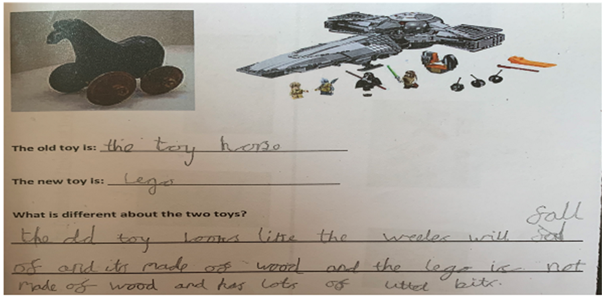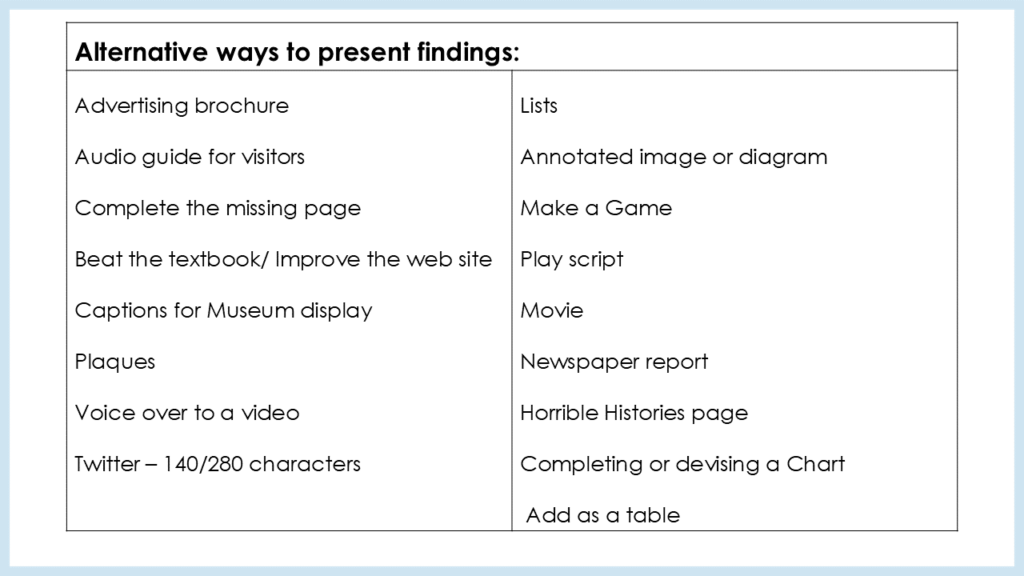Sue Temple, Senior Lecturer in Primary History, Quality Mark Assessor for the Historical Association, member of the HA primary committee 2006-2023, regular contributor to Primary History, previously a teacher in a Pupil Referral Unit and Early Years teacher as well as general primary.
Unless we use a much more creative approach like the one outlined in the previous page, your history lessons are likely to include some written tasks. Some schools use their history units as a context for their longer writing tasks. This is fine if the actual writing is done in English lessons and not your history lessons! For SEND children, a longer task like this needs to be broken down into stages so they can understand how to approach it.
For example:
Step 1 – Find the information – Children research with the big question in mind.
Step 2 – Organising your information to answer this question – Decide which information is useful? Reliable? How do you decide which to trust?
Step 3 – Reaching a conclusion- The conclusion you reach will depend which evidence you trust.
Step 4 -Deciding the best way to present your conclusion -Who is your audience? Do you want to make a poster or a PowerPoint or Sway? Would a radio interview or debate work better?
Step 5 – Presenting your conclusion – Pull it all together, making sure you are answering the question and using evidence to support your answer. Once your pupils understand this process it will help them to be much more independent – sometimes we ask a lot of our pupils without giving them the scaffolding they need!
Interactive word walls with images and word banks can also be useful for some children – but bear in mind others will struggle to transfer the information from the wall or your whiteboard to their page so prompts on the table may work better. You could also use Knowledge Organisers stuck in their books but be careful about how much information these include – link this to the reading capabilities of your class or group of children. These sometimes work better if the children add the information to them rather than being presented with a lot of information. Writing frames can be another useful support. Providing sentence stems to get children going with their writing or providing a sentence structure or example can be helpful. But do be careful you are not giving them closed examples where only one answer will work as this can make the task even more difficult for children if they are expected to guess what is in your mind!

ST ADD ADDITIONAL EXAMPLE IMAGES
Some Key things to think about:
- Modelling is the cornerstone of scaffolding. Show them an example of the outcome. Demonstrate the process thinking aloud and modelling your thought process. Children’s cognitive abilities are still in development so opportunities to see developed, critical thinking are essential.
- Link to Prior knowledge – make explicit links, share hunches, best guesses, explain your thinking. Your pupils may need hints/suggestions but more likely to grasp understanding of the content if they do the thinking.
- Time to Talk – Time to process the information, rehearse verbally – think-pair-share, talk partners, turn and talk, triad teams. If your pupils have rehearsed what they need to write verbally they will cope with the writing much better. “Think it, say it, like it, write it.”
- Pre teach and practice vocabulary to give your SEND children lots of opportunities to use the vocabulary and match to meanings, explore roots of the words to give children mental images of the words and help them understand them.
- Use visual aids – picture clues, relevant images, graphic organisers, pause, ask questions, pause, review.
Some alternatives to a diary entry or letter:
Many of the lesson plans my trainee teachers give me include a diary entry or letter written ‘in role’ without realising that this is one of the most difficult tasks we can ask in history. Your pupils will need a thorough knowledge and understanding of the period in order to do this successfully – think about how much hinterland knowledge they will actually need and how much they will actually have! A ‘Big Write’ is also a common task so what about some alternatives?

Some more tips:
For SEND, use pictures – place on a chart. For higher abilities, don’t use pictures but instead have a word bank or Knowledge Organiser available. Sometimes pre-populated, sometimes generate own and sorting.
- Extend tasks by encouraging justification and reasoning.
- Everyone does the same but with slight adaptations of expectations.
- Don’t re-write again for publishing or display.
- Look at the last three pieces of writing. If your SEND writing outcome is different then the tasks leading up to the outcome must also be different.
- Think about the culture you are creating around the use of resources: make concrete resources available to everybody, like we do in maths. Use talk tins or ipads or QR codes to record their responses.
- Allow children to dictate their work at times.
- Make strategies accessible to everyone and model them yourself.
